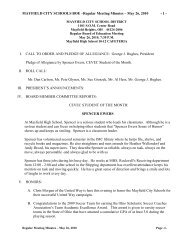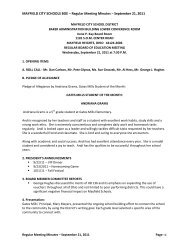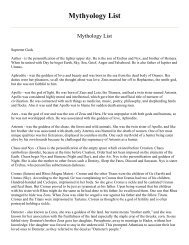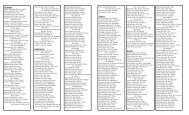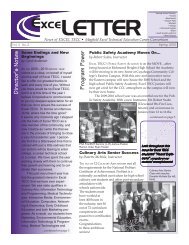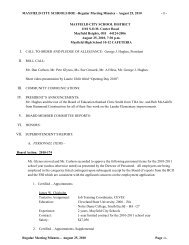2012 Rube Goldberg Proje Rube Goldberg Project Guidelines oject ...
2012 Rube Goldberg Proje Rube Goldberg Project Guidelines oject ...
2012 Rube Goldberg Proje Rube Goldberg Project Guidelines oject ...
You also want an ePaper? Increase the reach of your titles
YUMPU automatically turns print PDFs into web optimized ePapers that Google loves.
<strong>2012</strong> <strong>Rube</strong> <strong>Goldberg</strong> <strong>Proje</strong>ct <strong>Guidelines</strong><br />
Objective:<br />
Each student or group of students will construct a <strong>Rube</strong> <strong>Goldberg</strong> machine consisting of cons consecutive cons<br />
energy transfers that will result in inflating and popping a balloon in two separate mechanical steps. steps<br />
Who o was <strong>Rube</strong> <strong>Goldberg</strong> and wh what is a <strong>Rube</strong> <strong>Goldberg</strong> Machine?<br />
<strong>Rube</strong> <strong>Goldberg</strong> (1883 – 1970) was a Pulitzer Prize winning cartoonist, sculptor, and author. <strong>Goldberg</strong><br />
became renowned for creating absurdly connected machines that functioned in extremely complex and<br />
roundabout ways in order to accomplish a very basic task. While most machines made complex tasks<br />
much simpler, <strong>Goldberg</strong>’s inventions worked in reverse – transforming a simple task into a complicated<br />
sequence of energy transfers.
Requirements:<br />
1. You may work alone or in groups of up to three people to construct your <strong>Rube</strong> <strong>Goldberg</strong> machine.<br />
2. If you work alone or in a pair, your machine must consist of at least seven (7) distinct energy<br />
transfers that lead to the final step of watering the plant. If you work in a group of three, you must<br />
utilize ten (10) distinct energy transfers. While these are the minimum requirements, you are<br />
encouraged to do more.<br />
3. Teams will be given 3 attempts to accomplish the task on the day of the testing. For each trial that<br />
fails, 5 points will be deducted from the score.<br />
4. In addition to the completion of the basic task, your group must produce a step-by-step explanation<br />
of your <strong>Rube</strong> <strong>Goldberg</strong> machine. Explanations should include schematic drawings or digital pictures<br />
depicting each energy transfer and the setup of your machine. While the explanations and drawings<br />
will not be graded based on artistic ability, they should clearly explain and depict the energy<br />
transfers occurring and be professional in nature.<br />
5. In order to keep your group on track, you must submit a rough version of your step-by-step<br />
explanation by December 21, 2010 as a progress check.<br />
6. The testing of the machines will take place on January 10, 2010 during class in room 256.<br />
Therefore you must set up the machine either before class (in the morning or the previous<br />
afternoon) or during class.<br />
7. You may bring your own balloon or use the balloon that is provided by Mr. Rice.<br />
8. All machines will also be judged for originality, design and entertainment.<br />
a. A vote will be held to decide which machine has the overall best design or theme<br />
b. A vote will be held to decide the single most original energy transfer across all machines<br />
c. A vote will be held to decide the most entertaining machine overall<br />
Grading:<br />
At least 7 energy transfers (10 for trios) 40 points (2 extra points for each additional energy<br />
transfer, without exceeding 100 points total)<br />
Successful completion of task 15 points (5 point deduction for each failed trial)<br />
Step-by-Step Explanation with diagrams 30 points<br />
Progress Check 15 points<br />
Total 100 points (plus any bonus points)<br />
Three Bonus competitions<br />
a. Best design/theme—Vote<br />
b. Most original energy transfer—Vote<br />
c. Most entertaining overall—Vote<br />
Each bonus competition can earn you 5 bonus<br />
points, and these points can be added even if they<br />
increase your score beyond the perfect 100 points<br />
(These are the most valuable bonus points to get)
Action-Day Performance Rubric<br />
Qualifying Energy Transfers (40+ points)<br />
If you work alone or in a pair, your machine must consist of at least seven (7) distinct energy transfers that lead to<br />
the final steps of inflating and popping the balloon. If you work in a group of three, you must utilize ten (10)<br />
distinct energy transfers. While these are the minimum requirements, you are encouraged to do more.<br />
Clarification on the descriptions used for a single “distinct energy transfer”<br />
• Must be documented in the Step-by-Step Explanation handed in on Action-Day<br />
• Kinetic energy is transferred by some means from one object to another<br />
Ex: A falling baseball lands in a cup that pulls on a string…<br />
o If electrical systems are used (it is encouraged for diversity) an isolated electrical component can<br />
only count for a maximum of two transitions: an input and output<br />
Input example: a level lowers on to an electrical button<br />
Output example: a motor (turned on by the button) pulls a string<br />
o Repeating series<br />
A locally repeating process counts as one object with two transitions: an input and an<br />
output (Ex: a series of dominoes counts as one object, with an input to start the first<br />
domino to fall, and an output the last domino causes to happen)<br />
Any energy transition can only qualify once and, if repeated elsewhere in the machine,<br />
will only be counted once.<br />
• Inflating the balloon and popping the balloon must happen in two distinct energy steps.<br />
o The use of professionally manufactured electric inflators (i.e. air-mattress inflators) will receive a<br />
5 point deduction in your overall score, and are discouraged.<br />
o The balloon cannot pop itself through over inflation<br />
o The balloon cannot pop by inflating into a stationary needle<br />
Energy Transfer 1 Energy Transfer 2 Energy Transfer 3 Energy Transfer 4 Energy Transfer 5<br />
Quick description: Quick description: Quick description: Quick description: Quick description:<br />
Energy Transfer 6 Energy Transfer 7 Energy Transfer 8 Energy Transfer 9 Energy Transfer 10<br />
Quick description: Quick description: Quick description: Quick description: Quick description:<br />
6pts/transfer for pairs or smaller<br />
Successful Completion of Task (15 points)<br />
Teams will be given 3 attempts to accomplish the task on the day of the testing. For each trial that fails, 5 points<br />
will be deducted from the score. A smiley will be drawn at your successful attempt below.<br />
Trial #1____________ Trail #2____________ Trial #3___________ Score Earned_______________<br />
Running Time: ______________________________
Step-by-Step Explanation<br />
The images and descriptions will be graded based on the following requirements. Each individual<br />
transition is scored separately, and those scores are compiled to determine the grade for the report.<br />
1. Images, which can be hand-drawn or photographed (3pts max)<br />
a. Clearly show the energy transfer<br />
b. Energy input, potential, and output is labeled<br />
i. Arrows or circles that clarify where the energy is coming from and going to<br />
2. Explanation of energy transition (7pts max)<br />
a. Identify the kinetic (or other) energy that is used to start the energy transition(1pt)<br />
b. Identify the potential energy that must be stored for the transition to work(2pts)<br />
c. Describe the type of energy output- what happens as a result of the transition(2pts)<br />
d. Describe a plausible problem that could cause this transition to fail(2pts)<br />
i. HINT: This may be something that you have to consider during construction<br />
Energy Transfer 1 Energy Transfer 2 Energy Transfer 3 Energy Transfer 4 Energy Transfer 5<br />
Picture: Picture: Picture: Picture: Picture:<br />
Explanation: Explanation: Explanation: Explanation: Explanation:<br />
Energy Transfer 6 Energy Transfer 7 Energy Transfer 8 Energy Transfer 9 Energy Transfer 10<br />
Picture: Picture: Picture: Picture: Picture:<br />
Explanation: Explanation: Explanation: Explanation: Explanation:<br />
Total score earned: _____________/( X transitions needed_____)= Score percentage _____________<br />
Score percentage (from above) X 30pts = final score __________________
* **There is always a<br />
capacity for this<br />
document to change.<br />
An attempt to note any<br />
changes will be made in<br />
class.



